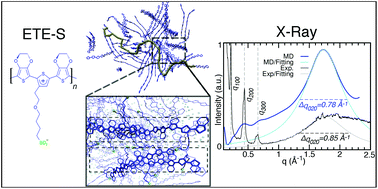Morphology of a self-doped conducting oligomer for green energy applications†
Abstract
A recently synthesized self-doped conducting oligomer, salt of bis[3,4-ethylenedioxythiophene]3thiophene butyric acid, ETE-S, is a novel promising material for green energy applications. Recently, it has been demonstrated that it can polymerize in vivo, in plant systems, leading to a formation of long-range conducting wires, charge storage and supercapacitive behaviour of living plants. Here we investigate the morphology of ETE-S combining the experimental characterisation using Grazing Incidence Wide Angle X-ray Scattering (GIWAXS) and atomistic molecular dynamics (MD) simulations. The GIWAXS measurements reveal a formation of small crystallites consisting of π–π stacked oligomers (with the staking distance 3.5 Å) that are further organized in h00 lamellae. These experimental results are confirmed by MD calculations, where we calculated the X-ray diffraction pattern and the radial distribution function for the distance between ETE-S chains. Our MD simulations also demonstrate the formation of the percolative paths for charge carriers that extend throughout the whole structure, despite the fact that the oligomers are short (6–9 rings) and crystallites are thin along the π–π stacking direction, consisting of only two or three π–π stacked oligomers. The existence of the percolative paths explains the previously observed high conductivity in in vivo polymerized ETE-S. We also explored the geometrical conformation of ETE-S oligomers and the bending of their aliphatic chains as a function of the oligomer lengths.



 Please wait while we load your content...
Please wait while we load your content...